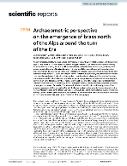Archaeometric perspective on the emergence of brass north of the Alps around the turn of the Era

Autor
Frank Danielisová, Alžběta
Magna, Tomáš
Datum vydání
2022Publikováno v
Scientific ReportsRočník / Číslo vydání
12 (1)ISBN / ISSN
ISSN: 2045-2322Metadata
Zobrazit celý záznamKolekce
Tato publikace má vydavatelskou verzi s DOI 10.1038/s41598-021-04044-7
Abstrakt
Ancient brass (aurichalcum) was a valued commodity in the Antiquity, notably because of its gold-like appearance. After mastering brass fabrication using the cementation procedure in the first century BC in the Mediterranean, this material became widely used by the Romans for coins, jewellery and other artefacts. Because of its visual qualities, it is believed that since this period, brass played an important role in diplomatic and economic contacts with indigenous communities, notably Celtic and Germanic tribes north of Danube and west of Rhine. To test this hypothesis, we performed for the first time the advanced statistical multivariate analysis based on chemical composition and lead isotope systematics, coupled with informed typo-chronological categorisation, of a suite of late Iron Age and Early Roman period (first century BC - first century AD) brass and other copper-alloy artefacts from the territory of Bohemia. In order to to discuss their provenance, the results were compared to known contemporary sources of material. The new results for brass artefacts from this early phase of the massive occurrence of Roman aurichalcum in the Barbarian territories point to the ore deposits in the western Mediterranean or the Massif Central area in Gaul, consistent with historical events. These new findings underscore the great economic and political importance of the new and rich mineral resources in the Transalpine Gaul acquired due to Caesar's military campaigns.
Klíčová slova
Roman, artifacts, metal
Trvalý odkaz
https://hdl.handle.net/20.500.14178/1836Licence
Licence pro užití plného textu výsledku: Creative Commons Uveďte původ 4.0 International







